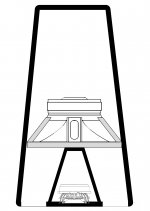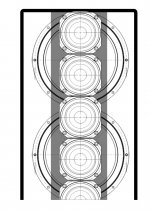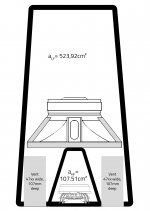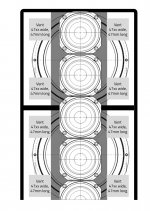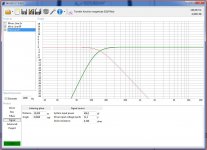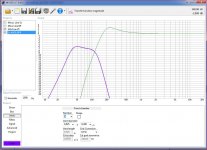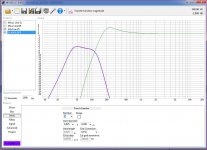Redrawed the initial sketch, now it's really 1:1, enclosure would be 250mm wide by 430mm deep 2290mm high(external).
Attachments
Last edited:
The difference is in the transparency which makes it look like there is a baffle across the front in white which is where I would put the vents.
I would build a test cab for one woofer with the area for the TC9 cabinet included. Measure it without the baffle then add a baffle over the front with the vents.
Then you will know what the difference is between the options that fit your wish for a slim tower.
Ah, I see 🙂
That will be one of the next steps, as soon as the final form is established. Have to build a test case for the TC9 as well.
I meant each driver in it's enclosure (at least at the front) and separate vents per driver in front of the driver so the array effect is maintained vertically.
So, what you mean is like this?
Attachments
Last edited:
Yes more like that but I would probably go with round ports and use plumbing pipe or slot ports and make them part of the sides of the cabinet. I think two bigger ones would be easier to tune in reality as the simulation will certainly not be bang on.So, what you mean is like this?
You now need to think about how much volume there will be in the front chamber minus the actual vent areas then you can get a better sim. It may be more or less than you are simulating now.
Here is an example of the same configuration with 47mm square ports 107mm long with a 7 litre rear chamber. I have changed the front chamber from 1 to 6 litres and you can see that the smaller chamber has more of a band pass peak with wider bandwidth, the bigger the chamber the lower the bandwidth but less of a peak. In a real enclosure the peak won't be quite as bad as a predicated but it is still easy to EQ out.
That's one of the things I like about Hornresp it has an EQ section and you can see how easy it will be to try and flatten the hump with a basic PEQ.
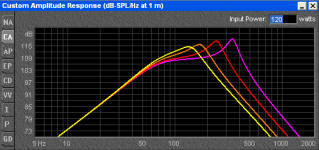
Well, two round ports per speaker definitely make life easier. And slot ports I'd love even more. 🙂
At the moment, I have the following gross volumes:
Vfront= 3,75l
Vrear= 11,53l
which sims really bad. Will try and reduce Vrear...
Edit:
Vrear = 8,2l
Vents changed to 2# 25x200mm, vent lenght according toWinISD 1,6m😕
At the moment, I have the following gross volumes:
Vfront= 3,75l
Vrear= 11,53l
which sims really bad. Will try and reduce Vrear...
Edit:
Vrear = 8,2l
Vents changed to 2# 25x200mm, vent lenght according toWinISD 1,6m😕
Attachments
Last edited:
Well, two round ports per speaker definitely make life easier. And slot ports I'd love even more. 🙂
At the moment, I have the following gross volumes:
Vfront= 3,75l
Vrear= 11,53l
which sims really bad. Will try and reduce Vrear...
Edit:
Vrear = 8,2l
Vents changed to 2# 25x200mm, vent lenght according toWinISD 1,6m😕
Why do you think it is bad?
If you have more output that you EQ away then you increase headroom and reduce distortion in that area. Changing the rear volume will just adjust the low end rolloff which I imagine you will EQ anyway. Make the rear as big as you need to reduce amplifier power needed to get back to the same point.
Vent length is based on the area of the port 25x200mm = 50cm2 in comparison to a 60mm diameter port at 28.3 cm2
,I think the big problem is, if you want reasonably big area of the vents, they become very long.
That was why I suggested putting them behind the enclosure and make them vertical instead of horizontal.
That was why I suggested putting them behind the enclosure and make them vertical instead of horizontal.
,I think the big problem is, if you want reasonably big area of the vents, they become very long.
That was why I suggested putting them behind the enclosure and make them vertical instead of horizontal.
Which I fully understood 🙂 Thank you!
At the moment I am thinking about folding the vents to have them on the front again.
,I think the big problem is, if you want reasonably big area of the vents, they become very long.
That was why I suggested putting them behind the enclosure and make them vertical instead of horizontal.
The vents only need to be long if you want to tune them low and avoid the bandpass peak. You can have big short vents just like a synergy and I don't think anyone considers those to sound bad in a PA application.
I actually think you could just mount the woofers on the front baffle with the TC9 drivers to one side. If you are crossing in the 100Hz region then there shouldn't be an interference issue given the wavelengths. The cabinet will be wider but only by the width of a TC9 which isn't much. Easier to control the chamber volume to whatever you want as you don't have it in front of the woofer. You could even make the cabinets separately and have them joined when you want them to be. Less weight in each one so they are easier to move.
The vents only need to be long if you want to tune them low and avoid the bandpass peak. You can have big short vents just like a synergy and I don't think anyone considers those to sound bad in a PA application.
I actually think you could just mount the woofers on the front baffle with the TC9 drivers to one side. If you are crossing in the 100Hz region then there shouldn't be an interference issue given the wavelengths. The cabinet will be wider but only by the width of a TC9 which isn't much. Easier to control the chamber volume to whatever you want as you don't have it in front of the woofer. You could even make the cabinets separately and have them joined when you want them to be. Less weight in each one so they are easier to move.
I totally agree..
Redrawed the initial sketch, now it's really 1:1, enclosure would be 250mm wide by 430mm deep 2290mm high(external).
Widely spaced tweeters are going to lead to very bad lobing in the vertical plane. Is this acceptable in your application?
Cheers, Carl.
Widely spaced tweeters are going to lead to very bad lobing in the vertical plane. Is this acceptable in your application?
Cheers, Carl.
There are no tweeters, this is a line array of full range drivers with a line of woofers behind it in the drawing.
There are no tweeters, this is a line array of full range drivers with a line of woofers behind it in the drawing.
Any array with driver spacing less than about 1/4 wavelength will give lobing problems...
Any array with driver spacing less than about 1/4 wavelength will give lobing problems...
Comb filtering above 8 KHz or 16KHz depending on distance from the array happens but they have a very even vertical response from the line array effect. There are plenty of white papers and measurements that back this up.
In a traditional arrangement of mid and tweeter what you say is true but that is not what is happening here.
CTC distance of the full range drivers is 83 to 85mm depending on how close you mount them.
- Status
- Not open for further replies.
- Home
- Live Sound
- PA Systems
- Two-way line source for church sound
